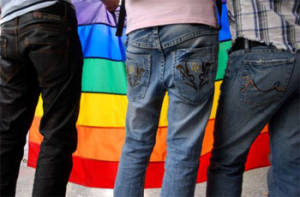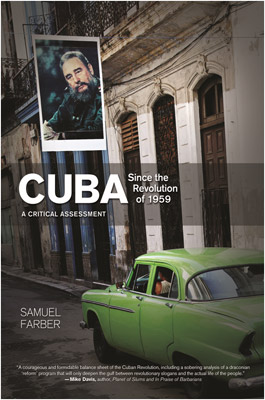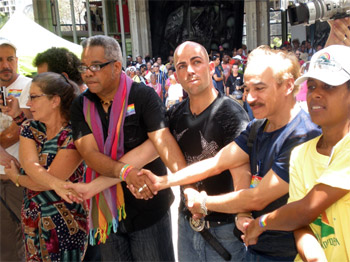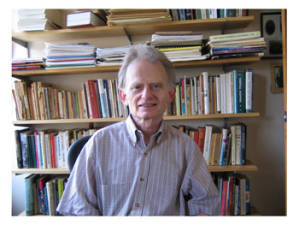Gays in Cuba after the Revolution
The fifth of six installments from “Cuba Since the 1959 Revolution”

HAVANA TIMES, Dec 16 — In spite of not having been allowed to organize independently to articulate and defend their interests, Cuban women benefited in some ways from the revolutionary process. Some traditional forms of patriarchal sexism have become weakened, such as the power of husbands at home.
Women’s incorporation into the labor force and the occasional implementation of affirmative action policies have led to a much greater occupational differentiation and to a larger number of women playing prominent roles in the economy and society.
However, the opposite has been the case for Cuban gays, who have suffered greatly, particularly during the first thirty years of the revolutionary period. For reasons that will be elucidated later on, the Cuban government forced gays out of the closet and politicized their situation to significantly increase their oppression.
As part of this process, the revolutionary leadership created a climate of opinion that not only dismissed gay oppression as a legitimate issue but also portrayed gay life as a symptom of social decay.
 Part 1: Cuba, The Unity of the People
Part 1: Cuba, The Unity of the People
Part 2: Cuba’s Workers After the Revolution
Part 3: Understanding Racism in Post-Revolution Cuba
Part 4: Women in Cuba: Education and Employment before the Revolution.
For example, when in 1967 the British House of Lords accepted the Wolfenden Report and abolished the UK’s laws against sodomy, the Cuban press portrayed the event as a further example of the decline of the British empire. Bohemia, Cuba’s most influential magazine, marked the beginning of the gay liberation movement in the United States with a cartoon portraying, in a derogatory manner, two men getting married in a church ceremony.160
A long series of events are “high” points of the decades-long trajectory of the persecution of gay Cubans by the revolutionary government. As early as 1962, the government conducted a massive raid known as the “night of the three Ps,” that is, prostitutas (female prostitutes), proxénetas (pimps), and pájaros (birds, one of the many derogatory Cuban terms for gay men). The raid netted thousands of people who were arrested and taken to police stations and city jails.
The “operation” involved indiscriminate raids in certain neighborhoods—such as Colón, near Old Havana—known for their high concentration of prostitutes. This was accompanied by selective raids on people reported as sexual deviants on lists prepared by the CDRs. That is how the well-known gay playwright Virgilio Piñera ended up being arrested in his house, located some distance from Havana.161

In his March 13, 1963, speech at the University of Havana attacking lazy children of the bourgeoisie who imitated Elvis Presley and organized “freelance effeminate” shows, Fidel Castro explained that it was not so easy to straighten out an adult homosexual, or as he put it, “a tree that had grown twisted.”
Therefore, no drastic measures would be adopted against them, but young people aspiring to be homosexuals were a different matter. Castro added that he had observed that the Cuban countryside did not produce the “subproduct” of homosexuality.162
Then, in 1965 the government erected the UMAP camps, where for some three years gays, along with Jehovah’s Witnesses, many practitioners of Catholicism, members of Afro-Cuban secret societies such as Abakúa, and other “deviants” were forced to provide cheap, regimented labor for the Cuban state.163
At about the same time, the Cuban state also established the Center for Special Education for boys considered to be “effeminate” and those raised by single mothers who were considered “at risk” of becoming homosexuals. The separation of these children from the regular public schools was obligatory since it was believed that they could “infect” their classmates.164
Coinciding with the international revolutionary year of 1968, the Cuban state undertook a “revolutionary offensive” at home. However, this was not an offensive against powerful and oppressive private and state structures as in Mexico City, Chicago, Paris, and Prague, but against the poorest and most marginal sectors of what remained of the Cuban petty bourgeoisie.
To ensure that no nook or cranny of the Cuban economy remained outside the ownership and control of the state, all tiny businesses, including large numbers of small bodegas and bars, were either taken over by the government or closed.

This was accompanied by a renewed persecution of homosexuals and prostitutes. In his speech of September 28, 1968, celebrating the eighth anniversary of the establishment of the CDRs, Fidel Castro denounced young Cubans whom he described as living in an “extravagant manner.” These included those with long hair and fancy clothes, which were signs of moral degeneracy that would ultimately lead to political and economic sabotage.
According to Castro, those youngsters were trying to introduce in Cuba a revived version of the Prague Spring, with street-walking prostitutes, the sale of women, parasitism, and ideological softening. He advocated forced labor in agriculture as punitive reeducation.
The pronouncements of Castro and other revolutionary spokespeople were followed by mass shavings of long-haired men and the sending of miniskirted girls accused of sexual looseness to do forced labor in the countryside.165
Castro also purged and imprisoned the “micro faction” of old Communists in February and supported the Soviet invasion of Czechoslovakia in August of that year.
This was followed by the “Quinquenio Gris” (Five Gray Years), which began in 1971 with the National Congress of Education and Culture resolving that because of the influence they could have on Cuban youth, “notorious homosexuals” were not to be tolerated in spite of their “artistic merits.”
Homosexuals who had direct influence on youth via artistic and cultural activities were to be transferred to other organizations.
The congress also resolved that people whose morals undermined the prestige of the revolution would be barred from any group of performers representing Cuba abroad.166 Some gay artists and intellectuals were protected from the drastic effects of the 1971 resolutions because of their links to institutions that enjoyed a certain degree of clout with Fidel Castro, in part because they were led by internationally prestigious and influential figures.

Such were the cases of Alicia Alonso’s Cuban National Ballet, Alfredo Guevara’s ICAIC (film institute), and Haydée Santamaría’s Casa de las Américas, the internationally known cultural center in Havana.
The official marginalization of gays had been anticipated by the University of Havana when it inaugurated in the mid-sixties a three-year-long campaign through the distribution of homophobic literature encouraging the repudiation of enfermitos (little sick ones) by fellow students and the public trials of hundreds of students.
The purges required all students enrolled in a given department to attend a mass assembly to question the political attitudes and behavior of their classmates.
The “jury” of the official student organization and the Communist Youth called witnesses to testify from the floor, but witnesses were afraid to defend accused students for fear of being accused themselves.
These purges were aimed at both “counterrevolutionaries” and homosexuals, with the usual unanimous verdict of “guilty” resulting in expulsion from the university and inclusion of the assembly’s findings in the expedientes (workplace and career records kept by the state) that were beginning to be used by this time.
By the fall of 1965, purges had become so frequent that the leader of the Communist Youth promised to refrain from holding them during class time.167
The decade of the eighties began in spring 1980 with the Mariel exodus, which was used by the government as another opportunity not only to ridicule and attack gays but also to force their departure from the country.
Some straight Cubans pretended to be gay in order to obtain the necessary government clearances and permissions to leave the island. In the United States, the National Gay Task Force (NGTF) estimated that out of a total of some 125,000 who left Cuba at that time, between 2,000 and 10,000 of the refugees were gay men and lesbians.168
Shortly after the Mariel exodus, the AIDS crisis broke out in the United States and elsewhere, eventually reaching Cuba. The Cuban government responded with some of the most extreme measures anywhere in the world.
Mandatory screening for HIV infection began in 1986. The first tests focused on the highest-risk groups: those who had traveled abroad since 1975, particularly soldiers who had served in Africa.
By April 1991, 9,771,691 people, almost the entire population, had been tested. HIV-positive people (902 cases in early 1993) were quarantined in sanatoriums and once they developed full-blown AIDS were transferred to hospitals.

Although medical attention and living conditions in the sanatoriums were admittedly good and the policy was effective in reducing contagion, the government’s policy was internationally criticized for its unnecessary harshness and ruthless display of state power over individuals.
Basically healthy people were forced to live isolated, nonproductive lives while waiting to develop full-blown AIDS, a process that sometimes took many years, to then be moved to a hospital.169
As Marvin Leiner has pointed out, the quarantine policy was used as a substitute for the absence of a serious educational program on AIDS. As with the Victorians’ response to syphilis and gonorrhea, the Cuban government was trying to deal with AIDS while avoiding public discussion or education about sex and how to practice safe sex to limit the transmission of the virus.170
The quarantine policy was discontinued in the nineties, but the earlier choices that the Cuban government made in dealing with AIDS revealed a lot about its historic attitudes to sex and sexual education, as well as about the vast capacities of the Cuban leviathan.
—-
Notes:
160. Allen Young, Gays under the Cuban Revolution (San Francisco: Grey Fox Press, 1981), 31.
161. Carlos Franqui, Retrato de familia con Fidel (Barcelona: Editorial Seix Barral, 1981), 280–86; Manuel Zayas, “Mapa de la homofobia,” cubaencuentro, 15 febrero 2010, http://
cubaencuenro.com/es/cuba/articulos/mapa-de-la-homofobia-10736.
162. Departamento de Versiones Taquigráficas del Gobierno Revolucionario, “Discurso pronunciado por el Comandante Fidel Castro Ruz, primer ministro del gobierno revolucionario de Cuba, en la clausura del acto para conmemorar el VI aniversario del asalto al palacio presidencial celebrado en la escalinata de la Universidad de la Habana, 13 de marzo de 1963,” cuba.cu, www.cuba.cu/gobierno/discursos/1963/esp/f130363e.html.
163. Lumsden, Machos, Maricones and Gays, 65–70.
164. Guerra, “Gender Policing, Homosexuality and the New Patriarchy,” 274.
165. Thomas, Cuba: The Pursuit of Freedom, 1971, 1435; Guerra, “Gender Policing, Homosexuality and the New Patriarchy,” 271.
166. Cited from excerpts from Granma Weekly Review, May 9, 1971, 5, in Young, Gays under the Cuban Revolution, 32–33.
167. Young, Gays under the Cuban Revolution, 53; Guerra, “Gender Policing, Homosexuality and the New Patriarchy, 1965–1970,” 282.
168. Young, Gays under the Cuban Revolution, 34–35.
169. Leiner, Sexual Politics in Cuba: Machismo, Homosexuality and AIDS, 117–18.
170. Ibid., 122, 138.
CUBA SINCE THE REVOLUTION OF 1959
A Critical Assessment
Copyright Samuel Farber 2011.
(www.haymarketbooks.org)






Samuel you fail to point out that the 1986-89 quarantine for HIV+ patents (for all its over-protectiveness) was not about gays (in an article that was otherwise all about gays), and that HIV+ patients back in the late 1980s were mainly heterosexual – homosexual men did not become a majority of HIV+ people in Cuba until about the mid 1990s
Answer to Larry,
Yes, there is a treatment of the issues you raised in another part of the chapter.
samuel farber
While being an interesting historical account of the earlier years of the Cuban revolution the installment stops rather abruptly leaving the reader hanging some two and a half decades ago. Will there be a second part compiling the accounts and activities of the latter twenty five years and twenty first century developments?
L.